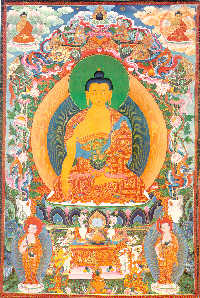| |
Tangka
( 2005-10-27 )
 Thangka, seen in every monastery and family shrine in Tibet, is actually a kind of Tibetan scroll-banner painting and is a unique art form that belongs to the Tibetan culture. Thangka, seen in every monastery and family shrine in Tibet, is actually a kind of Tibetan scroll-banner painting and is a unique art form that belongs to the Tibetan culture.
Thangka has been in vogue in Tibet for centuries. In Tibetan, "Thang" means "unfolding" or "displaying", and Thangka means "silk, satin or cloth painting scroll". It is most often painted on scrolls or embroidered on wall hangings of silk or other cloth. Common at monasteries, lamas' residences, family halls for worshipping Buddha and homes of Tibetan Buddhists, Thangka is a mark of devotion toBuddhismand often serves as an object of worship.
The content of Thangka has various subjects such as historical events, personage biographies, religious doctrines, Tibetan natural conditions and social customs, folklores, mythical stories, images of great deities and Buddhas, and Jataka stories of the Buddha, etc., involving politics, economy, history, religion, literature and art, social life, Tibetan astrology, pharmacology, theology and many other respects. The structure of Tibet Thangka is precise, balanced, plumpy and changeful. The painting methods are mainly bright color and line drawing.
Thangka always has a theme of Buddhism, and the artists must follow the sacred laws for portraying gods and Buddhas. Passages from scriptures are written in vermilion on the back, and Thangka is always unsigned, so it is next to impossible to know the painter and the age of ancient Thangkas.
|
|

